3-Pentanone,2,4-dibromo-2,4-dimethyl-

3-Pentanone,2,4-dibromo-2,4-dimethyl- structure
|
Common Name | 3-Pentanone,2,4-dibromo-2,4-dimethyl- | ||
|---|---|---|---|---|
| CAS Number | 17346-16-6 | Molecular Weight | 271.97800 | |
| Density | 1.61 g/mL at 25ºC(lit.) | Boiling Point | 89-91ºC13 mm Hg(lit.) | |
| Molecular Formula | C7H12Br2O | Melting Point | N/A | |
| MSDS | Chinese USA | Flash Point | 163 °F | |
| Symbol |

GHS07 |
Signal Word | Warning | |
| Name | 2,4-dibromo-2,4-dimethylpentan-3-one |
|---|---|
| Synonym | More Synonyms |
| Density | 1.61 g/mL at 25ºC(lit.) |
|---|---|
| Boiling Point | 89-91ºC13 mm Hg(lit.) |
| Molecular Formula | C7H12Br2O |
| Molecular Weight | 271.97800 |
| Flash Point | 163 °F |
| Exact Mass | 269.92500 |
| PSA | 17.07000 |
| LogP | 2.90250 |
| Vapour Pressure | 0.241mmHg at 25°C |
| Index of Refraction | n20/D 1.506(lit.) |
| Storage condition | Flammables area |
Synonym:None Known Section 2 - COMPOSITION, INFORMATION ON INGREDIENTS
Risk Phrases: 10 36/37/38 Section 3 - HAZARDS IDENTIFICATION EMERGENCY OVERVIEW
Flammable. Irritating to eyes, respiratory system and skin.Lachrymator (substance which increases the flow of tears). Potential Health Effects Eye: Produces irritation, characterized by a burning sensation, redness, tearing, inflammation, and possible corneal injury. Lachrymator (substance which increases the flow of tears). May cause chemical conjunctivitis and corneal damage. Skin: Causes skin irritation. May cause cyanosis of the extremities. Ingestion: May cause gastrointestinal irritation with nausea, vomiting and diarrhea. The toxicological properties of this substance have not been fully investigated. Ingestion of large amounts may cause CNS depression. Inhalation: Causes respiratory tract irritation. The toxicological properties of this substance have not been fully investigated. Aspiration may lead to pulmonary edema. Vapors may cause dizziness or suffocation. May cause burning sensation in the chest. Chronic: Effects may be delayed. Section 4 - FIRST AID MEASURES Eyes: Immediately flush eyes with plenty of water for at least 15 minutes, occasionally lifting the upper and lower eyelids. Get medical aid. Do NOT allow victim to rub eyes or keep eyes closed. Skin: Get medical aid. Flush skin with plenty of water for at least 15 minutes while removing contaminated clothing and shoes. Wash clothing before reuse. Ingestion: Never give anything by mouth to an unconscious person. Get medical aid. Do NOT induce vomiting. If conscious and alert, rinse mouth and drink 2-4 cupfuls of milk or water. Wash mouth out with water. Inhalation: Remove from exposure and move to fresh air immediately. If not breathing, give artificial respiration. If breathing is difficult, give oxygen. Get medical aid. Do NOT use mouth-to-mouth resuscitation. Notes to Physician: Treat symptomatically and supportively. Section 5 - FIRE FIGHTING MEASURES General Information: As in any fire, wear a self-contained breathing apparatus in pressure-demand, MSHA/NIOSH (approved or equivalent), and full protective gear. Vapors may form an explosive mixture with air. Vapors can travel to a source of ignition and flash back. During a fire, irritating and highly toxic gases may be generated by thermal decomposition or combustion. Will burn if involved in a fire. Use water spray to keep fire-exposed containers cool. Containers may explode in the heat of a fire. Flammable liquid and vapor. Vapors may be heavier than air. They can spread along the ground and collect in low or confined areas. Runoff from fire control or dilution water may cause pollution. Extinguishing Media: For small fires, use dry chemical, carbon dioxide, water spray or alcohol-resistant foam. For large fires, use water spray, fog, or alcohol-resistant foam. Use water spray to cool fire-exposed containers. Water may be ineffective. Do NOT use straight streams of water. Section 6 - ACCIDENTAL RELEASE MEASURES General Information: Use proper personal protective equipment as indicated in Section 8. Spills/Leaks: Absorb spill with inert material (e.g. vermiculite, sand or earth), then place in suitable container. Avoid runoff into storm sewers and ditches which lead to waterways. Clean up spills immediately, observing precautions in the Protective Equipment section. Remove all sources of ignition. Use a spark-proof tool. Provide ventilation. A vapor suppressing foam may be used to reduce vapors. Section 7 - HANDLING and STORAGE Handling: Ground and bond containers when transferring material. Use spark-proof tools and explosion proof equipment. Avoid breathing dust, vapor, mist, or gas. Avoid contact with eyes, skin, and clothing. Empty containers retain product residue, (liquid and/or vapor), and can be dangerous. Keep container tightly closed. Keep away from heat, sparks and flame. Avoid ingestion and inhalation. Use only in a chemical fume hood. Wash clothing before reuse. Do not pressurize, cut, weld, braze, solder, drill, grind, or expose empty containers to heat, sparks or open flames. Storage: Keep away from sources of ignition. Store in a cool, dry place. Store in a tightly closed container. Flammables-area. Section 8 - EXPOSURE CONTROLS, PERSONAL PROTECTION Engineering Controls: Facilities storing or utilizing this material should be equipped with an eyewash facility and a safety shower. Use adequate general or local explosion-proof ventilation to keep airborne levels to acceptable levels. Exposure Limits CAS# 17346-16-6: Personal Protective Equipment Eyes: Wear appropriate protective eyeglasses or chemical safety goggles as described by OSHA's eye and face protection regulations in 29 CFR 1910.133 or European Standard EN166. Skin: Wear appropriate protective gloves to prevent skin exposure. Clothing: Wear appropriate protective clothing to prevent skin exposure. Respirators: Follow the OSHA respirator regulations found in 29 CFR 1910.134 or European Standard EN 149. Use a NIOSH/MSHA or European Standard EN 149 approved respirator if exposure limits are exceeded or if irritation or other symptoms are experienced. Section 9 - PHYSICAL AND CHEMICAL PROPERTIES Physical State: Liquid Color: clear colorless to light amber Odor: Not available. pH: Not available. Vapor Pressure: Not available. Viscosity: Not available. Boiling Point: 57 - 58 deg C @ 12.00mmHg Freezing/Melting Point: Not available. Autoignition Temperature: Not available. Flash Point: 54 deg C ( 129.20 deg F) Explosion Limits, lower: Not available. Explosion Limits, upper: Not available. Decomposition Temperature: Solubility in water: Specific Gravity/Density: 1.4000g/cm3 Molecular Formula: C7H12BrO Molecular Weight: 191.98 Section 10 - STABILITY AND REACTIVITY Chemical Stability: Stable at room temperature in closed containers under normal storage and handling conditions. Conditions to Avoid: Incompatible materials, ignition sources, excess heat. Incompatibilities with Other Materials: Oxidizing agents. Hazardous Decomposition Products: Carbon monoxide, carbon dioxide. Hazardous Polymerization: Has not been reported Section 11 - TOXICOLOGICAL INFORMATION RTECS#: CAS# 17346-16-6 unlisted. LD50/LC50: Not available. Carcinogenicity: 2,4-Dibromo-2,4-Dimethyl-3-Pentanone - Not listed by ACGIH, IARC, or NTP. Section 12 - ECOLOGICAL INFORMATION Section 13 - DISPOSAL CONSIDERATIONS Dispose of in a manner consistent with federal, state, and local regulations. Section 14 - TRANSPORT INFORMATION IATA Shipping Name: FLAMMABLE LIQUID, N.O.S. Hazard Class: 3 UN Number: 1993 Packing Group: III IMO Shipping Name: FLAMMABLE LIQUID, N.O.S. Hazard Class: 3.3 UN Number: 1993 Packing Group: III RID/ADR Shipping Name: FLAMMABLE LIQUID, N.O.S. Hazard Class: 3 UN Number: 1993 Packing group: III Section 15 - REGULATORY INFORMATION European/International Regulations European Labeling in Accordance with EC Directives Hazard Symbols: XI Risk Phrases: R 10 Flammable. R 36/37/38 Irritating to eyes, respiratory system and skin. Safety Phrases: S 9 Keep container in a well-ventilated place. S 16 Keep away from sources of ignition - No smoking. S 26 In case of contact with eyes, rinse immediately with plenty of water and seek medical advice. S 33 Take precautionary measures against static discharges. S 37/39 Wear suitable gloves and eye/face protection. WGK (Water Danger/Protection) CAS# 17346-16-6: No information available. Canada None of the chemicals in this product are listed on the DSL/NDSL list. CAS# 17346-16-6 is not listed on Canada's Ingredient Disclosure List. US FEDERAL TSCA CAS# 17346-16-6 is not listed on the TSCA inventory. It is for research and development use only. SECTION 16 - ADDITIONAL INFORMATION N/A |
| Symbol |

GHS07 |
|---|---|
| Signal Word | Warning |
| Hazard Statements | H315-H319-H335 |
| Precautionary Statements | P261-P305 + P351 + P338 |
| Personal Protective Equipment | Eyeshields;full-face respirator (US);Gloves;multi-purpose combination respirator cartridge (US);type ABEK (EN14387) respirator filter |
| Hazard Codes | Xi |
| Risk Phrases | R36/37/38 |
| Safety Phrases | S26 |
| RIDADR | UN 3334 |
| WGK Germany | 3 |
| HS Code | 2914700090 |
|
~% 
3-Pentanone,2,4... CAS#:17346-16-6 |
| Literature: Journal of the Chemical Society, Perkin Transactions 1: Organic and Bio-Organic Chemistry (1972-1999), , p. 2513 - 2516 |
|
~% 
3-Pentanone,2,4... CAS#:17346-16-6 |
| Literature: US5847120 A1, ; |
|
~% 
3-Pentanone,2,4... CAS#:17346-16-6 |
| Literature: Zhurnal Russkago Fiziko-Khimicheskago Obshchestva, , vol. 44, p. 1381 Journal fuer Praktische Chemie (Leipzig), , vol. <2>88, p. 683 |
| Precursor 4 | |
|---|---|
| DownStream 9 | |
| HS Code | 2914700090 |
|---|---|
| Summary | HS: 2914700090 halogenated, sulphonated, nitrated or nitrosated derivatives of ketones and quinones, whether or not with other oxygen function Tax rebate rate:9.0% Supervision conditions:none VAT:17.0% MFN tariff:5.5% General tariff:30.0% |
|
Electroreduction of. alpha.,. alpha.'-dibromoketones. 2, 4-Dibromo-2, 4-dimethyl-3-pentanone. Dirlam JP, et al.
J. Am. Chem. Soc. 94(1) , 240-45, (1972)
|
|
|
Debromination of. alpha.,. alpha. 1-dibromo ketones with a zinc-copper couple in dimethylformamide and dimethylacetamide. New reaction yielding 2-dimethylamino-4-methylene-1, 3-dioxolanes. Hoffmann HMR, et al.
J. Am. Chem. Soc. 94(9) , 3201-4, (1972)
|
|
|
Electrochemical reduction of. alpha.,. alpha.'-dibromo ketones in acetic acid. Convenient synthetic route to highly branched. alpha.-acetoxy ketones. Fry AJ and O'Dea JJ.
J. Org. Chem. 40(25) , 3625-31, (1975)
|
| 2,4-Dimethyl-2,4-dibromo-3-pentanone |
| MFCD00051923 |
| 2,4-dibromo-2,4-dimethyl-pentan-3-one |
| 2.4-Dibromo-2.4-dimethylpentanone |
| 2,4-dibromo2,4-dimethyl-3-pentanone |
| 2,3-DODECADIENOIC ACID |
| 2,4-Dibrom-2,4-dimethyl-pentan-3-on |
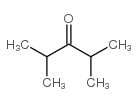
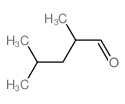

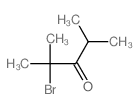
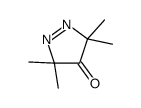 CAS#:30467-62-0
CAS#:30467-62-0 CAS#:3212-68-8
CAS#:3212-68-8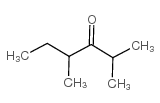 CAS#:18641-70-8
CAS#:18641-70-8 CAS#:27132-81-6
CAS#:27132-81-6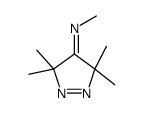 CAS#:72443-11-9
CAS#:72443-11-9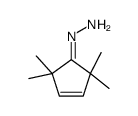 CAS#:81396-37-4
CAS#:81396-37-4 CAS#:86096-09-5
CAS#:86096-09-5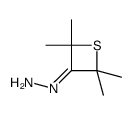 CAS#:89050-85-1
CAS#:89050-85-1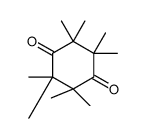 CAS#:52999-01-6
CAS#:52999-01-6